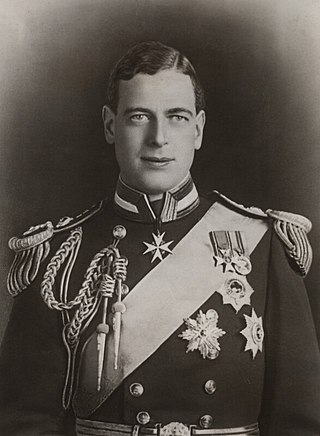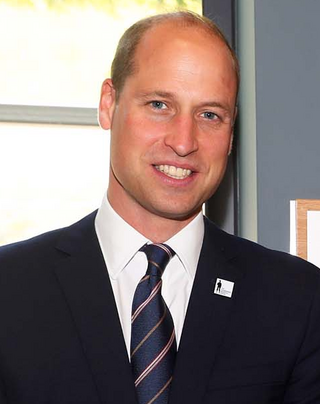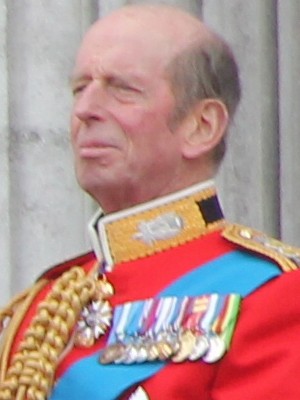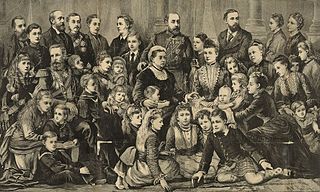Prince Edward may refer to:

Mary of Teck was Queen of the United Kingdom and the British Dominions, and Empress of India, from 6 May 1910 until 20 January 1936 as the wife of King-Emperor George V.

Edward is an English male given name. It is derived from the Anglo-Saxon name Ēadweard, composed of the elements ēad "wealth, fortune; prosperous" and weard "guardian, protector”.

Duke of York is a title of nobility in the Peerage of the United Kingdom. Since the 15th century, it has, when granted, usually been given to the second son of English monarchs. The equivalent title in the Scottish peerage was Duke of Albany. However, King George II and King George III granted the titles Duke of York and Albany.

Mountbatten-Windsor is the personal surname used by some of the male-line descendants of Queen Elizabeth II and Prince Philip, Duke of Edinburgh. Under a declaration made in Privy Council in 1960, the name Mountbatten-Windsor applies to male-line descendants of Queen Elizabeth II without royal styles and titles. Individuals with royal styles do not usually use a surname, but some descendants of the Queen with royal styles have used Mountbatten-Windsor when a surname was required.

Prince Edward, Duke of Kent and Strathearn, was the fourth son and fifth child of King George III and Queen Charlotte. His only child, Victoria, became Queen of the United Kingdom 17 years after his death.

Prince George, Duke of Kent, was a member of the British royal family, the fourth son of King George V and Queen Mary. He was a younger brother of kings Edward VIII and George VI. Prince George served in the Royal Navy in the 1920s and then briefly as a civil servant. He became Duke of Kent in 1934. In the late 1930s he served as an RAF officer, initially as a staff officer at RAF Training Command and then, from July 1941, as a staff officer in the Welfare Section of the RAF Inspector General's Staff. He was killed in Dunbeath air crash on 25 August 1942.

Duke of Kent is a title that has been created several times in the peerages of Great Britain and the United Kingdom, most recently as a royal dukedom for the fourth son of King George V. Since 1942, the title has been held by Prince Edward, Queen Elizabeth II's cousin.

Duke of Cambridge is a hereditary title of nobility in the British royal family, one of several royal dukedoms in the United Kingdom. The title is named after the city of Cambridge in England. It is heritable by male descendants by primogeniture, and has been conferred upon various members of the British royal family several times throughout history.

Prince of the United Kingdom of Great Britain and Northern Ireland is a royal title normally granted to sons and grandsons of reigning and past British monarchs, together with consorts of female monarchs. The title is granted by the reigning monarch, who is the fount of all honours, through the issuing of letters patent as an expression of the royal will.

The use of the title of Princess of the United Kingdom of Great Britain and Northern Ireland is entirely at the will of the sovereign as expressed in letters patent. Individuals holding the title of princess are styled "Her Royal Highness" (HRH). On 18 April 1917, Frederica of Hanover, the newest granddaughter of Wilhelm II, German Emperor was styled a British princess from birth, even though Germany and Britain were fighting in World War I. Before the First World War, British princesses also held additional German titles, such as princesses of Hanover by virtue of being male-line descendants of George III; or princesses of Saxe-Coburg and Gotha, duchess of Saxony, by virtue of being male-line descendants of Prince Albert of Saxe-Coburg and Gotha. George V issued letters patent on 30 November 1917, to restrict the automatic assignment of the title "princess" and the use of the style "Royal Highness" to the following persons:
Earl of Dublin is a title that has been created three times in British and Irish history.

The Grand Master of the Order of St Michael and St George is the second most senior officer of the Order of St Michael and St George. The Grand Master is appointed by the British monarch as Sovereign of the Order of St Michael and St George and ranks immediately after the Sovereign.

By the arrangements of the Canadian federation, the Canadian monarchy operates in Prince Edward Island as the core of the province's Westminster-style parliamentary democracy. As such, the Crown within Prince Edward Island's jurisdiction is referred to as the Crown in Right of Prince Edward Island, His Majesty in Right of Prince Edward Island, or the King in Right of Prince Edward Island. The Constitution Act, 1867, however, leaves many royal duties in Prince Edward Island specifically assigned to the sovereign's viceroy, the lieutenant governor of Prince Edward Island, whose direct participation in governance is limited by the conventional stipulations of constitutional monarchy.

Queen Victoria, the British monarch from 1837 to 1901, and Prince Albert had 9 children, 42 grandchildren, and 87 great-grandchildren.
Honouring individuals buried in Westminster Abbey has a long tradition.

St George's Chapel at Windsor Castle in England is a castle chapel built in the late-medieval Perpendicular Gothic style. It is a Royal Peculiar, and the Chapel of the Order of the Garter. St George's Chapel was founded in the 14th century by King Edward III and extensively enlarged in the late 15th century. It is located in the Lower Ward of the castle.
Since William the Conqueror claimed the English throne, succession has been determined by bequest, battle, primogeniture, and parliament.

Duchess of Edinburgh is the principal courtesy title held by the wife of the Duke of Edinburgh. There have been five Duchesses of Edinburgh since the title's creation. Following the accession of Charles III in 2022, the 3rd creation of the Dukedom of Edinburgh merged in the Crown. Following his parents’ wishes, on 10 March 2023, Charles III conferred the title Duke of Edinburgh to his youngest brother, Prince Edward, and his wife, Sophie, became the Duchess of Edinburgh.